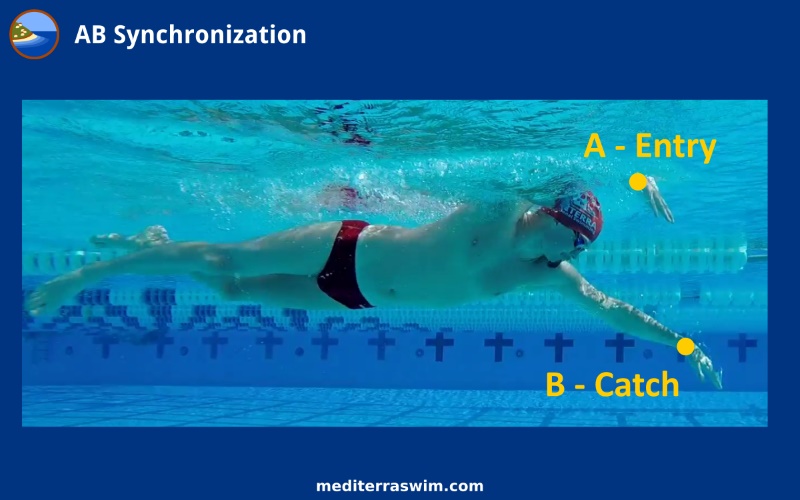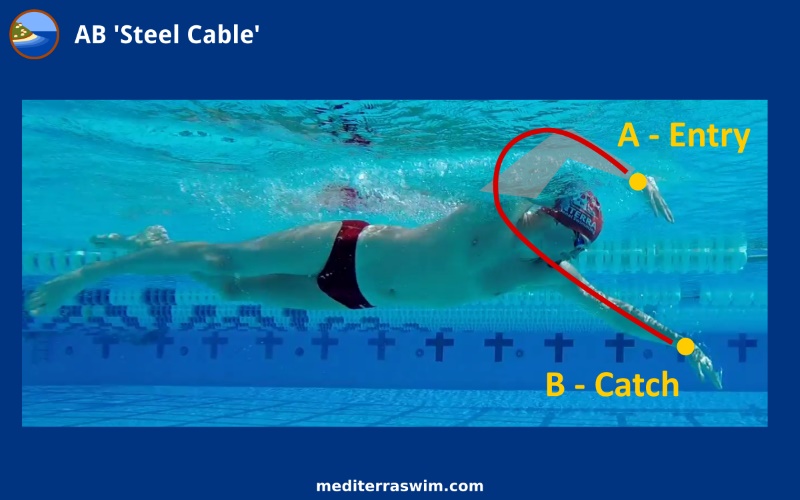Forums › Library › Swim Course Instructions › AB Synchronization Intro
Please type your comments directly in the reply box - DO NOT copy/paste text from somewhere else into the reply boxes - this will also copy the code behind your copied text and publish that with your reply, making it impossible to read. Our apology for the inconvenience, but we don't see a convenient way of fixing this yet.
Tagged: catch, entry, extension, propulsion, synchronization
-
AuthorPosts
-
January 1, 2018 at 18:33 #16623
Admin Mediterra
Keymaster
There is an ideal timing for the switch of the arms in front of the body. In the image above you can see the entry hand piercing the water just across from the elbow of the lead arm. This is about the ideal moment for the arms to switch positions. Now the lead arm can begin the catch.
Just before this moment, the lead arm continues to extend forward while waiting for the recovery arm to come fully forward. Note that the lead arm is not passively hanging there – that side of the body is actively stretching the whole time. The Skate side of the body feels long and firm and getting longer.
There is some small room for adjustment depending on the tempo, but in general the ideal timing is to have the catch begin at the moment the entry hand has entered the water. For slower tempos your entry arm might be submerged to past the watch band by the time you set the catch, and for faster tempos your fingers may just start to pierce the water at the time you set the catch. But to switch earlier than this, or later than this is going to introduce greater ‘power leaks into your stroke.
Another way to phrase this is ‘arm overlap’. Notice how far the entry arm overlaps the lead arm in about the ideal amount. If you have too little overlap, or too much overlap at the moment the arms switch, then the catch is not able to connect with the full torso rotation, and ‘power leaks’ from the propulsive action. When there is just the right amount of overlap, then you are able to transfer force from the catch side to the entry side of the body instantaneously, and smoothly. Timing both sides with the full torso rotation is the key.
At the moment your entry hand is piercing the water, your torso begins to rotate. The ideal is to connect the catch to the start of this torso rotation also. Notice how all three must happen together.

Imagine a steel cable tying the catch wrist to the entry wrist. This cable passed through the shoulders. When one wrist moves the other must move in immediate response to it, in one smooth motion. The shoulder connect the two arms. When you set the catch on one side and start to press against the water, you instantly transfer that force – through that imaginary steel cable – into the entry arm. The entry arm slides down and then extends forward, receiving the force from the catch side of the body. This is how you generate and feel acceleration on each stroke. This is where the magic begins.
Instructions
First, in slower motion strokes, establish the ideal timing, or ‘overlap’ position and get very familiar with this.
To make the ideal zone more distinct in your nervous system, occasionally try too much overlap, and too little overlap in order to feel how those distortions cause your stroke to feel less connected, less effective. Notice how you get less acceleration.
Gradually speed up the tempo while maintaining this same ideal overlap. Eventually, you should be able to keep proper switch timing at every tempo you train with, from slow to sprint tempos.
Remember that the motion of the two arms, entry and catch sides, through the shoulders, should feel firmly connected to each other. You are aiming for a immediate, smooth transfer of force from one side of the body to the other, that gives you a sense of acceleration on each stroke.
The better the catch shape and pathway, the more force you generate that is available to be transferred to the other side.
The better your skate position, the farther your body is able to slide forward once it receives that force.
The better your arm switch timing (the amount of overlap), the more of that force is transferred to the other side.
-
AuthorPosts
- You must be logged in to reply to this topic.
